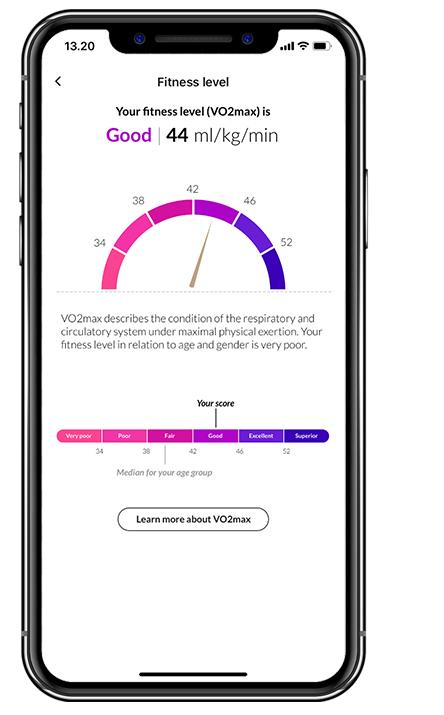Fitness Level (VO2max)
Fitness Level provides an accurate estimate of your aerobic fitness (endurance) and reveals if your physical fitness is supporting your health.

What does VO2max tell you?
The result shows if your current physical fitness is sufficient to support and promote good health.
Good fitness is associated with better health and performance. Poor fitness increases the risk of becoming ill and health risks like cardiovascular disease. The Fitness Level result can reveal information about our longer-term lifestyle.
Even a small improvement in fitness produces significant health benefits.
VO2max is estimated from a Fitness Level walk
The Fitness Level walk allows you to monitor your fitness level, and if needed, make some changes to your exercise habits.
Fitness Level is estimated from the relationship between walking speed and heart rate, and the result is expressed relative to your age and gender peers.
The result is calculated in proportion to your weight (ml/kg/min), which means that being significantly overweight will reduce your result.


Tips for a successful Fitness Level walk
Walking briskly and continuously on flat terrain for at least 30 minutes without carrying any heavy belongings will ensure a reliable result.
Factors that increase or decrease your heart rate affect the reliability of the estimation.
Your result might be underestimated:
If your heart rate increases more than normal, for example due to big hill inclines, carrying a heavy load, hot weather, or exercise before the walk.
Your result might be overestimated:
If you heart rate does not increase normally during the exercise, for example due to medication (beta-blockers) that decrease heart rate.
Good fitness improves recovery
Even a small increase in your fitness can increase the amount of recovery you experience, improve your well-being and add quality years to your life.
When your fitness is good, you can cope with life’s demands and even with harder daily tasks. You will feel better and more energetic in general.

Your fitness level is assessed in relation to results in your age group on a scale from very low – superior.
How to succeed
Poor fitness?
If you are currently very inactive, even a small increase in your daily activity improves your fitness. Start by taking breaks from sitting and adding light physical activity to your days as often as possible. Take short walks or do a bit of yard or housework.
When your fitness improves, you can gradually increase the duration and intensity of the physical activity.
If you already exercise regularly but your fitness level is still low, continue exercising but reflect on whether your exercise amount and intensity are balanced. If you are overweight, losing weight will also help improve your fitness.
Recommended sports include walking, swimming, cycling, group exercise, and yoga.
Moderate fitness?
To improve your fitness, you need moderate and vigorous exercise in addition to light physical activity. Try to incorporate 2h 30min of moderate (or 1h 15min of vigorous) physical activity over the course of a week. And remember to do some muscle strengthening and coordination exercises, too.
Recommended sports include cycling, jogging, gym, dancing, downhill skiing, rollerblading, and gymnastics.
Good fitness?
To further improve your fitness requires a progressive increase of training volume and intensity, paying attention to periodization, and varying training types. When the overall load increases, the need for sufficient recovery and energy (calorie intake) also increases.
Recommended sports include ball sports, running, gym, martial arts, and gymnastics.
